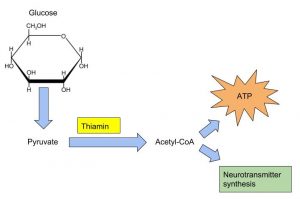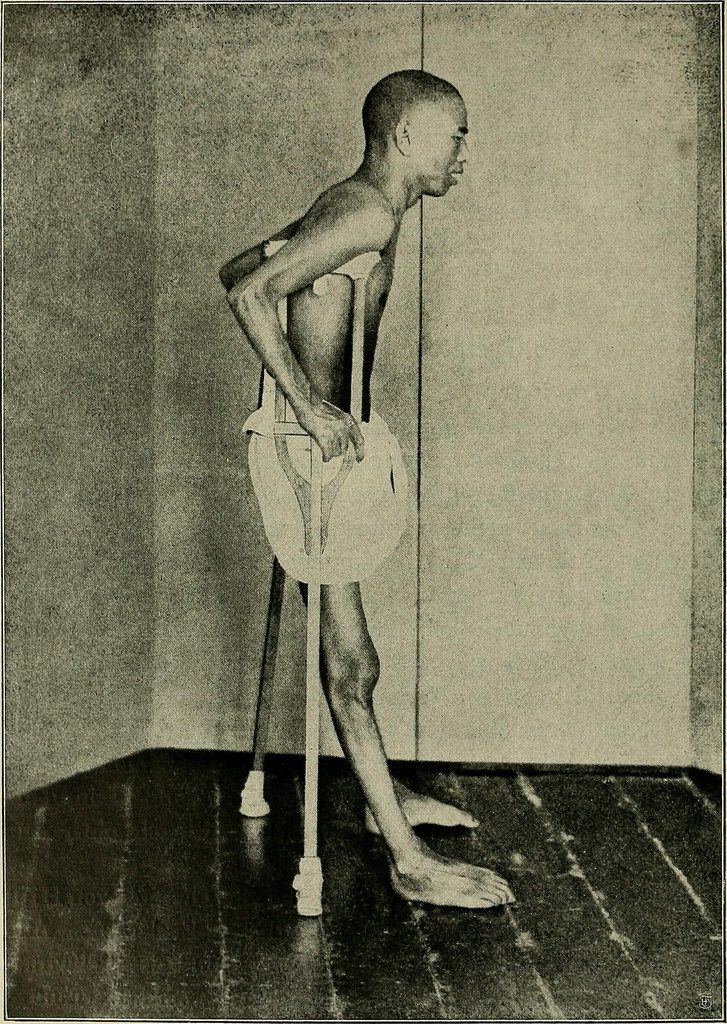Chapter 11: Micronutrients in Metabolism
11.1 Thiamin (Vitamin B1)
University of Hawai‘i at Mānoa Food Science and Human Nutrition Program
Thiamin (B1 )
Thiamin is especially important in glucose metabolism. It acts as a coenzyme for enzymes that break down glucose for energy production. Thiamin plays a key role in nerve cells as the glucose that is catabolized by thiamin is needed for an energy source. Additionally, thiamin plays a role in the synthesis of neurotransmitters and is therefore required for RNA, DNA, and ATP synthesis.
The brain and heart are most affected by a deficiency in thiamin. Thiamin deficiency, also known as beriberi, can cause symptoms of fatigue, confusion, movement impairment, pain in the lower extremities, swelling, and heart failure. It is prevalent in societies whose main dietary staple is white rice. During the processing of white rice, the bran is removed, along with what were called in the early nineteenth century, “accessory factors,” that are vital for metabolism. Dutch physician Dr. Christiaan Eijkman cured chickens of beriberi by feeding them unpolished rice bran in 1897. By 1912, Sir Frederick Gowland Hopkins determined from his experiments with animals that the “accessory factors,” eventually renamed vitamins, are needed in the diet to support growth, since animals fed a diet of pure carbohydrates, proteins, fats, and minerals failed to grow.[1]Eijkman and Hopkins were awarded the Nobel Prize in Physiology (or Medicine) in 1929 for their discoveries in the emerging science of nutrition.
Another common thiamin deficiency known as Wernicke-Korsakoff syndrome can cause similar symptoms as beriberi such as confusion, loss of coordination, vision changes, hallucinations, and may progress to coma and death. This condition is specific to alcoholics as diets high in alcohol can cause thiamin deficiency. Other individuals at risk include individuals who also consume diets typically low in micronutrients such as those with eating disorders, elderly, and individuals who have gone through gastric bypass surgery.[2]


Dietary Reference Intakes
The RDAs and ULs for different age groups for thiamin are listed in Table 11.11 “Dietary Reference Intakes for Thiamin”. There is no UL for thiamin because there has not been any reports on toxicity when excess amounts are consumed from food or supplements.
Table 11.11 Dietary Reference Intakes for Thiamin[3]
| Age Group | RDA Males and Females mg/day |
| Infants (0–6 months) | 0.2 * |
| Infants (7–12 months) | 0.3* |
| Children (1–3 years) | 0.5 |
| Children (4–8 years) | 0.6 |
| Children (9–13 years) | 0.9 |
| Adolescents (14–18 years) | 1.2 (males), 1.0 (females) |
| Adults (> 19 years) | 1.2 (males), 1.1 (females) |
| Pregnancy & Lactation | 1.4 |
| *denotes Adequate Intake | |
Dietary Sources
Whole grains, meat and fish are great sources of thiamin. The United States as well as many other countries, fortify their refined breads and cereals. For the thiamin content of various foods, see Table 11.12 “Thiamin Content of Various Foods”.
Table 11.12 Thiamin Content of Various Foods[4]
| Food | Serving | Thiamin (mg) | Percent Daily Value |
| Breakfast cereals, fortified | 1 serving | 1.5 | 100 |
| White rice, enriched | ½ c. | 1.4 | 73 |
| Pork chop, broiled | 3 oz. | 0.4 | 27 |
| Black beans, boiled | ½ c. | 0.4 | 27 |
| Tuna, cooked | 3 oz. | 0.2 | 13 |
| Brown rice, cooked, not enriched | ½ c. | 0.1 | 7 |
| Whole wheat bread | 1 slice | 0.1 | 7 |
| 2% Milk | 8 oz. | 0.1 | 7 |
| Cheddar cheese | 1 ½ oz | 0 | 0 |
| Apple, sliced | 1 c. | 0 | 0 |
- Frederick Gowland Hopkins and his Accessory Food Factors. Encyclopedia Brittanica Blog. http://www.britannica.com/blogs/2011/06/frederick-gowland-hopkins-accessory-food-factors/ [inactive]. Published June 20, 2011. Accessed October 1, 2011. ↵
- Fact Sheets for Health Professionals: Thiamin. National Institute of Health, Office of Dietary Supplements. https://ods.od.nih.gov/factsheets/Thiamin-HealthProfessional/. Updated Feburary 11, 2016. Accessed October 22, 2017. ↵
- Health Professional Fact Sheet: Thiamin. National Institutes of Health, Office of Dietary Supplements.https://ods.od.nih.gov/factsheets/Thiamin-HealthProfessional/ . Updated February 9, 2023 . Accessed August 2, 2023. ↵
- Health Professional Fact Sheet: Thiamin. National Institutes of Health, Office of Dietary Supplements.https://ods.od.nih.gov/factsheets/Thiamin-HealthProfessional/ . Updated February 11, 2016 . Accessed October 5, 2017. ↵
Together, all of the chemical reactions that take place inside cells, including those that consume or generate energy, are referred to as the cell’s metabolism.
Carbohydrates are a macronutrient composed of carbon, hydrogen, and oxygen in a 1:2:1 ratio and are soluble in water.
Nutrition is the sum of all processes involved in how organisms obtain nutrients, metabolize them, and use them to support all of life’s processes.

